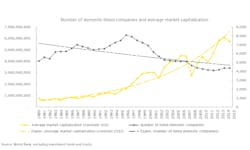Economists are finally getting around to evaluating the negative influence of the concentration of market power. There are two primary types of market concentrations. In a monopoly, of course, one seller dominates a market—such as Microsoft, which controls 90% of the computer operating systems market. An oligopoly occurs when a small number of firms dominate a single market segment. A good example are the four national meat packers who control the beef, pork and chicken markets.
Since 1999, the United States has undergone an enormous number of mergers and acquisitions. The following chart shows that there were 8,000 corporations in 1996. In 2015, there were less than 5,000. In most cases, the reduction was due to mergers and acquisitions, which has led to market concentrations where the dominant companies have thee power to control employment, wages, the supply chain, consumer pricing, and market share. Today, 90% of mergers are approved by the government.
Anybody who has taken a college economics course learned that capitalism is supposedly based on the ubiquity of competition. The premise is that economic power was to remain diffuse so that no company or companies could gain control over a market where they would be able to control both pricing and market share. In capitalist theory, competition is supposed to lead to innovation and more affordable prices for consumers. Without competition, a monopoly or oligopoly can develop. If a company (or companies) were able to get control of a market, they would be in a position to not only control prices, but also would begin the process of eliminating competition to gain market share. According to capitalist theory, this is not supposed to happen – but it is happening. Here are just a few examples:
Technology companies: Google now has a 92% share of the search engine market, according to the web traffic analysis site StatCounter, and Facebook controls almost 70% of social networks. Facebook purchased its two largest competitors, Instagram and What's App, without any regulatory challenges. The Apple iPhone and Google's android phone control the mobile app market. Apple, Samsung, and Huawei manufactured more than half of the 377 million smart phones shipped in 2018 worldwide. Technology companies are good examples of oligopolies that control their market share by buying up competitors. According to Market Watch, in the last decade, Google, Amazon, Facebook, and Microsoft have acquired 500 competitors.
Pharmaceutical companies: The special advantage of pharmaceutical companies is that they are issued patents for new drugs, which allows them monopoly pricing for 12 to 13 years. The largest firms then merge or acquire other firms that have patents, which gives them monopoly power in more drug markets. The bottom line is that drug prices in the United States are twice as high as all European drug prices. This keeps the profits of the pharmaceutical industry much higher than other industries. For instance, the 25 largest pharmaceutical corporations have an average profit margin of 20.1% versus the 25 largest software companies, which average 13.4% profit, according to a 2017 study by the U.S. Government Accountability Office.
Home appliance: There are now five major appliance manufacturers in the United States – Whirlpool, Electrolux, GE, LG, and Samsung. These major appliance manufacturers have increased their market concentration's by buying their competitors. Whirlpool now owns Jenn-Air, Maytag, Amana, Roper, and Kitchen Aid brands. Electrolux owns Frigidaire, Tappan, Kelvinator, and Gibson brands. GE Appliance, owned by Chinese company Haier, owns the Hot Point, Cafe, and Monogram brands.
Meat packers: There are now four large corporations that control 80% of the pork, beef, and chicken packing markets: JBS/Swift, Tyson, Cargill, and National Beef. In 1980, a hog farmer received 50% of the market price. Today, they receive 25% and only have four options to sell their hogs. This is a good example of how an oligopoly can control prices and reduce suppliers. For instance, there were 660,000 pig farms in 1982—today there are 71,000. During this same period, cattle ranches decreased from 1.6 million to 950,000 ranches. Besides consumers of meat products, the real victims of this oligopoly are family farms and cattle ranchers. The small cattle rancher has been replaced by big feedlots with a capacity of at least 50,000 head. (These numbers came from an article in the Huffington Post that quoted U.S. census data.)
This is only a small list of the current manufacturing monopolies and oligopolies in the United States. Monopolies and oligopolies can now be found in railroads, auto manufacturing, auto parts, food processing, consumer products, chemicals, oil and gas, and semiconductors; to name just a few. We are in a modern version of the Gilded Age, and there are many economic problems caused by these market concentrations.
Wages – As companies merge, they tend to cut jobs and freeze wages, regardless of productivity. Between 1973 and 2016, productivity increased 65%, while hourly wages for 80% of the workforce increased only 8%. Workers simply have less power to bargain for a fair wage. Monopolies and oligopolies have the power to reduce employee wages and benefits on the one hand and increase consumer prices on the other. This has been a significant contribution to inequality and the decline of the middle class.
Jobs – Mergers and acquisitions always result in duplication and almost always result in fewer workers supervisors and managers who must be eliminated to reach the projected overhead and savings of the new corporation. In 2009, when Pfizer acquired Wyeth, they announced they would cut 20,000 jobs. In 2015, when Heinz merged with Kraft, they announced they would cut their workforce by 5%. Cutting the workforce seems to be a requirement of mergers and acquisitions.
Higher prices – When trying to get a merger or acquisition approved, the corporations try to make the case that the merger will not increase consumer prices and will benefit the consumer. But after the merger is approved and they control the markets, price increases often follow. In fact, many mergers and acquisitions have led to price-fixing schemes for everything from antibiotics and generic drugs to credit transactions and auto parts. Gaining a dominant market share also allows the monopoly companies to use predatory pricing to force competitors out of the market.
Fewer suppliers – After a merger, the new corporation will also cut duplication of suppliers. Besides eliminating duplicate suppliers, the merging firms have tremendous leverage and can force the surviving suppliers to accept new financial terms. If you are a small manufacturer selling to Walmart, it will pressure you to lower your price by comparing the price to Chinese suppliers. Walmart has 1,000 American suppliers and 6,000 Asian suppliers.
Fewer startup companies - Startup companies have been dwindling since the late 1980s. According to the U.S. Bureau of Labor Statistics, 13% of all companies were startups in 1985, but only 8% in 2014. As merged corporations get closer to becoming oligopolies in the marketplace, they begin to not only control suppliers, but to control the potential of new startup businesses. For instance, when Walmart or Target comes into a town, it wipes out the small businesses on Main Street and there is little chance of starting a new mom-and-pop business. The same thing is true in high-tech businesses. When the giant tech companies are buying up small tech competitors, there is simply less room for innovators to break in.
So who are the beneficiaries?
The only real beneficiaries of mergers, monopolies, and oligopolies are the shareholders of the company and the senior managers who put the deals together. The senior managers become heroes because they are now in a position to control market pricing, increase profits, and increase the share price. The ultimate result is more money and power concentrated in fewer hands.
So why did this happen?
It happened because ever since 1980, there has been little enforcement of antitrust laws and the interpretation of anti-trust regulations has changed. Around 1980, economists at the Chicago School of Economics, driven by the theories of Milton Friedman, began to publish studies claiming that the enforcement of antitrust laws was hurting consumers by promoting wasteful competition. They argued that efficiency was more important and that regulations would impede growth and innovation. The subsequent deregulation of all but the most blatant forms of anti-competitive behavior led to a growth of mergers and acquisitions, which led to more oligopolies and monopolies.
For decades, economists, jurists, and both the Democratic and Republican parties believed in the efficiency without regulation assumption, and if consumers weren't harmed they ignored market concentrations. It has become a winner-take-all economy and the losers are workers, suppliers, manufacturing, and the economy.
I think that it is in the DNA of capitalism to gain the upper hand in a market. Corporations will always try to reduce competition and increase prices, unless they are regulated. Antitrust regulations need to be redefined with some specific language that insures competition and protects consumer pricing, market share, and supplier companies. By ignoring antitrust enforcement, we have inadvertently given more power and control to the few over the many.
Michael Collins is the author of The Rise Of Inequality and the Decline of the Middle Class.





